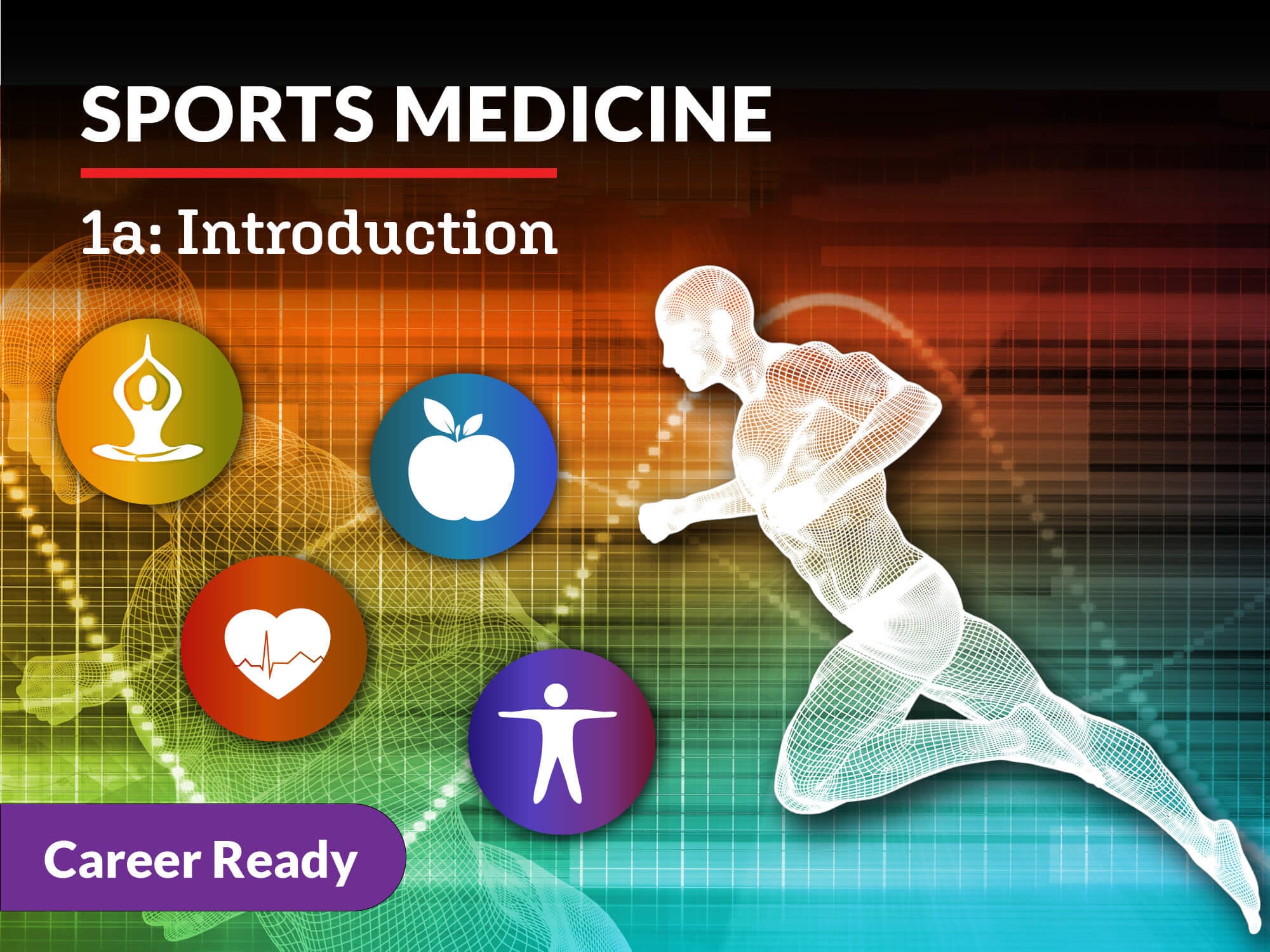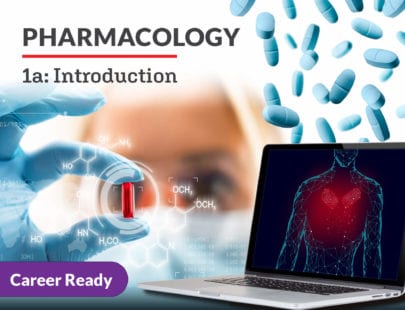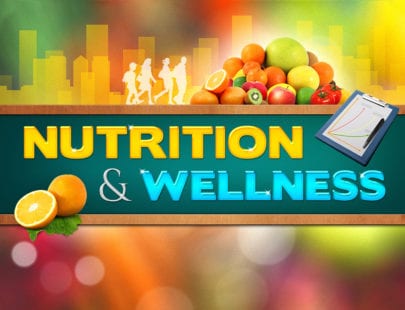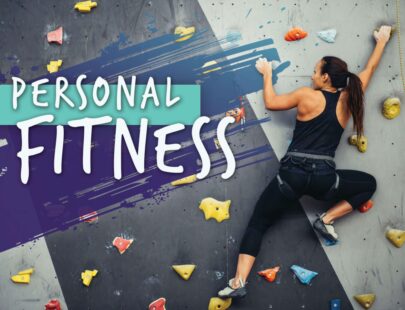
Sports Medicine 1a: Introduction
What do you think of when you hear the phrase “sports medicine professional”? Believe it or not, the term encompasses a much larger range of career options than jobs typically associated with this field. Explore some of the most popular career pathways, day-to-day responsibilities, emergency care for athletes, and legal obligations. Discover what nutrition, healthy lifestyle, and fitness truly mean, and dive into anatomy, human biomechanics, and exercise modalities. Learn how to get started in this exciting field.
Units at a Glance
Unit 1: Sports Medicine in Action
What do you think of when you hear the phrase “sports medicine professional”? Do you think of a doctor? Or maybe you think of a coach? Believe it or not, the term encompasses a much larger range of career options that expands further than jobs typically associated with this field. Would you believe that massage therapists, dietitians, and facility managers are considered to be part of the sports medicine industry? Together, we’ll take a deep dive into a few of the most popular career paths available in the field today. We will also take a look at and discuss some of the day-to-day duties and legal obligations of a sports medicine professional–ready? Let’s jump in!
What will you learn in this unit?
- Explore and explain the responsibilities of professionals in the sports medicine industry
- Discuss the legal obligations of a sports medicine professional
- Identify the day-to-day duties of a healthcare professional
- Describe the code of conduct and ethical responsibilities of any member of the athletic healthcare team
- Understand the importance of a lifetime of healthy living
Unit 2: Psychology, Healthy Living, and Body Image
Have you ever wondered, “what exactly does it mean to be healthy and how do I make sure that I stay healthy for the rest of my life?” In this day and age, health information is available virtually anywhere. The second you log on to Instagram, Facebook, or Twitter, you are bombarded with self-proclaimed “health experts” claiming they have the secret to a better you. But when it comes to health, what is “normal?” As it turns out, health should have a much broader focus than what we usually assume.
What will you learn in this unit?
- Define “fitness” and identify what a typical healthy lifestyle looks like
- Analyze the relationship between the brain and the body and how one affects the other
- Understand how pain and stress interact with overall health and how they lead to issues like drug abuse
- Recognize the causes, signs, and symptoms of eating disorders
- Develop strategies for planning healthy lifestyle
Unit 3: Introduction to Nutrition
Have you ever heard the term “you are what you eat?” Have you ever wondered what that means, and how it applies to your body’s needs? Together, we’ll explore all of the different types of nutrients consumed in a healthy diet. By understanding the effects different types of nutrients have on your body, and how to compare and contrast different types of foods to determine what is healthy for you, you will be set for success to maintain a well-balanced lifestyle. You will also begin to form the foundational knowledge about nutrition that guides all sports medicine professionals when making recommendations to their clients.
What will you learn in this unit?
- Discuss why nutrition is important to overall health
- Name and define the six classes of nutrients essential for health
- Distinguish between macro- and micronutrients
- Evaluate the dietary reference intakes for nutrients and how they apply to individuals
- Analyze the parts and meanings of a nutrition label
- Think critically about choosing a healthy diet versus a fad diet
Unit 4: Basics of the Body: Understanding Anatomy
Every day, you likely get out of bed and move throughout your day. Maybe you start your day with a morning walk through your neighborhood, or maybe you participate in a sport. But have you ever stopped to think about how your body moves, and what is it that allows you to get from one place to another? Let’s take a deep dive into the structure and function of the movement system of your body, your skeleton, and muscles. We’ll also take a look at the systems that work together to keep you alive and function each and every day.
What will you learn in this unit?
- Identify and describe the major functions and structures of the skeletal systems
- Describe and classify the types of joints in the human body
- Name and explain the purpose of the various layers of bone
- Understand the basic structure of organ systems of the body and how they work together
Unit 5: Exercise Modalities
You’ve made a life-changing decision and you want to start your journey towards being more physically fit, but where exactly do you begin? Good news! Here, you will uncover the components of a fitness program that will yield maximum success. You will also learn the scientific physiology and reasoning behind an exercise program and how variables of exercise can be altered to be unique to your needs. And, while you achieve results through proper exercise design, you will also explore the various ways you can track and evaluate the data throughout the exercise program. Ready? Let’s go!
What will you learn in this unit?
- Implement various modalities into the different phases of the progressive training model
- Describe common special considerations that will need to be made with various populations
- Evaluate appropriate program design protocol for various populations
- Identify fitness technologies used by fitness professionals
Unit 6: Communication and Coaching
Effective communication is vital for health and fitness professionals. Both professional and personal relationships can be enhanced when you are able to communicate honestly, openly, assertively, and, of course, with kindness. Such communication has the ability to reduce both personal stress and the stress felt by those surrounding you. Here you will learn how to enhance these skills that will ultimately help you understand your client on a deeper level and allow you guide people to achieve optimal results.
What will you learn in this unit?
- Communicate effectively with clients
- Motivate unmotivated individuals starting an exercise program
- Distinguish between different communication styles
- Understand the stages of behavior change
Unit 7: You’ve Got the Moves: Human Biomechanics
You may mistake physics as a subject that doesn’t have much to do with your daily life. But, think about it: on the inside, you have muscles, bones, and joints that allow your body to move, and on the outside, your body interacts with the space around it, which involves air, temperature, gravity, and outside forces. Analyzing human movement, and all the factors that impact it, is essential to any physical sport. And to be able to analyze the factors of movement, we need have a common language between all healthcare providers and researchers. For professionals in the sports medicine industry, it’s important to analyze not only the mechanics of human movement but also what that movement is called, if that movement caused injury, and it’s location in order to predict the damage that may have occurred. It might sound complicated but don’t worry – here, we’ll discuss the basic terminology, principles of movement, biomechanics, and forces that affect the human body.
What will you learn in this unit?
- Define biomechanics and explain the role it plays in an exercise training program
- Understand and explain the relationship between anatomical locations and planes of motion in basic biomechanics principles
- Describe axes of reference and labeling of muscle actions
- Use and apply anatomical terms, planes, and motions to create exercise programs
Unit 8: Emergency Preparedness
Members of the healthcare team have a legal duty to develop and implement an emergency action plan that is to be followed if an athlete becomes injured while participating in sports, whether in practice or during a big game. To be effective, the emergency plan must be carefully understood by all emergency action team members involved, including those on the athletic healthcare team. Let’s examine the components of an emergency action plan and what to do at the site of an injury.
What will you learn in this unit?
- Identify the importance of an emergency action plan
- Describe the components of an emergency action plan
- Perform the assessment to determine the state of an injured athlete’s vital signs
- Understand how to perform CPR and AED
- Utilize methods of protection against bacterial infection
Required Materials
Physical
- Video recording device
- Various props to demonstrate healthy lifestyle choices (weights, yoga mat, fruits, vegetables, etc.)
Software
- Word processing software
- Presentation software
Optional
- Posterboard and markers
- Camera


